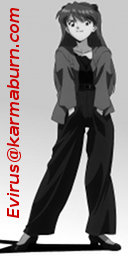|
|

It's not a metaphor.
With less than a week left before the start of the Spring 2024 anime season, I currently have 19 shows that I'm willing to at least try. Moreover, I compiled this list weeks ago without closely scrutinizing what series will even be airing in April. There's a good chance I've overlooked multiple anime I'd also consider, and I may have missed series that were announced only recently. Based on past experiences, what's likely to happen is I'll end up dropping a lot of these, but that still leaves a significant number of shows to follow.
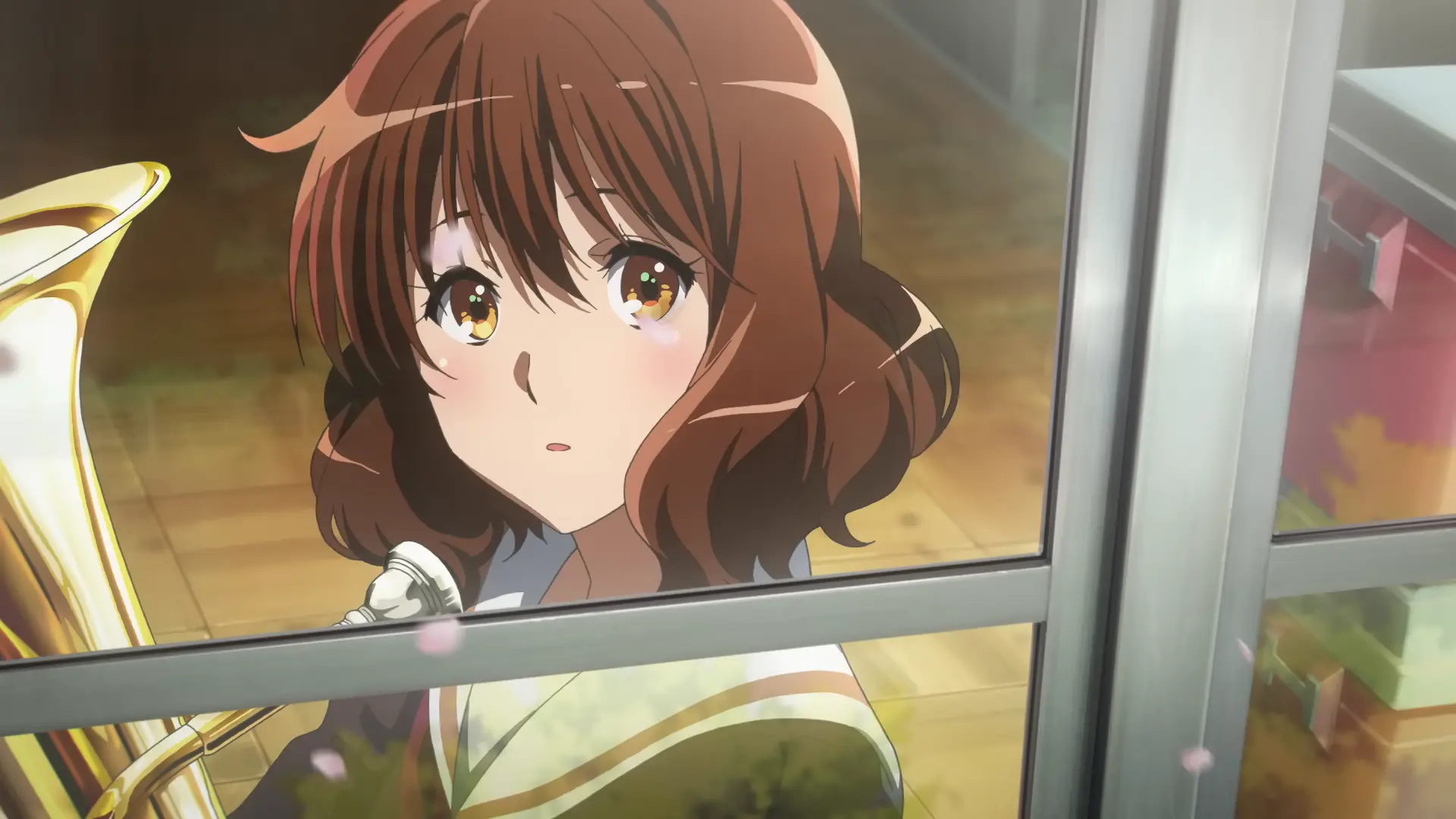
I didn't expect to like Hibike! Euphonium more now than when I started the series.
Some of these titles are a lock. For example, I'm guaranteed to follow Yuru Camp△ SEASON 3, Hibike! Euphonium 3, and Kono Subarashii Sekai ni Shukufuku wo! 3 (KONOSUBA -God's Blessing on This Wonderful World! 3), and Wonderful Precure! regardless of how they turn out. Likewise, I'll probably stick with Kimetsu no Yaiba: Hashira Geiko-hen (Demon Slayer: Kimetsu no Yaiba Hashira Training Arc) and The iDOLM@STER: Shiny Colors.

Everything know about Shiny idols, I learned from fan art.
Maou Gakuin no Futekigousha: Shijou Saikyou no Maou no Shiso, Tensei shite Shison-tachi no Gakkou e Kayou II Part 2 (The Misfit of Demon King Academy: History’s Strongest Demon King Reincarnates and Goes to School with His Descendants Season 2 Part 2) probably has enough momentum that I won't drop it outright, and I'm curious enough about the Spice and Wolf do-over (Ookami to Koushinryou: merchant meets the wise wolf) that I'll at least watch some of it, despite finding the first anime horribly overrated. Anyway, I support the assertion that good media do not need to be remade. Rather, it's the bad ones that would benefit from an opportunity at being unfucked. Since I have a generally negative opinion about the 2008 Spicy Wolf, then this remake should be right up my alley. I hope it's not bad a second time.
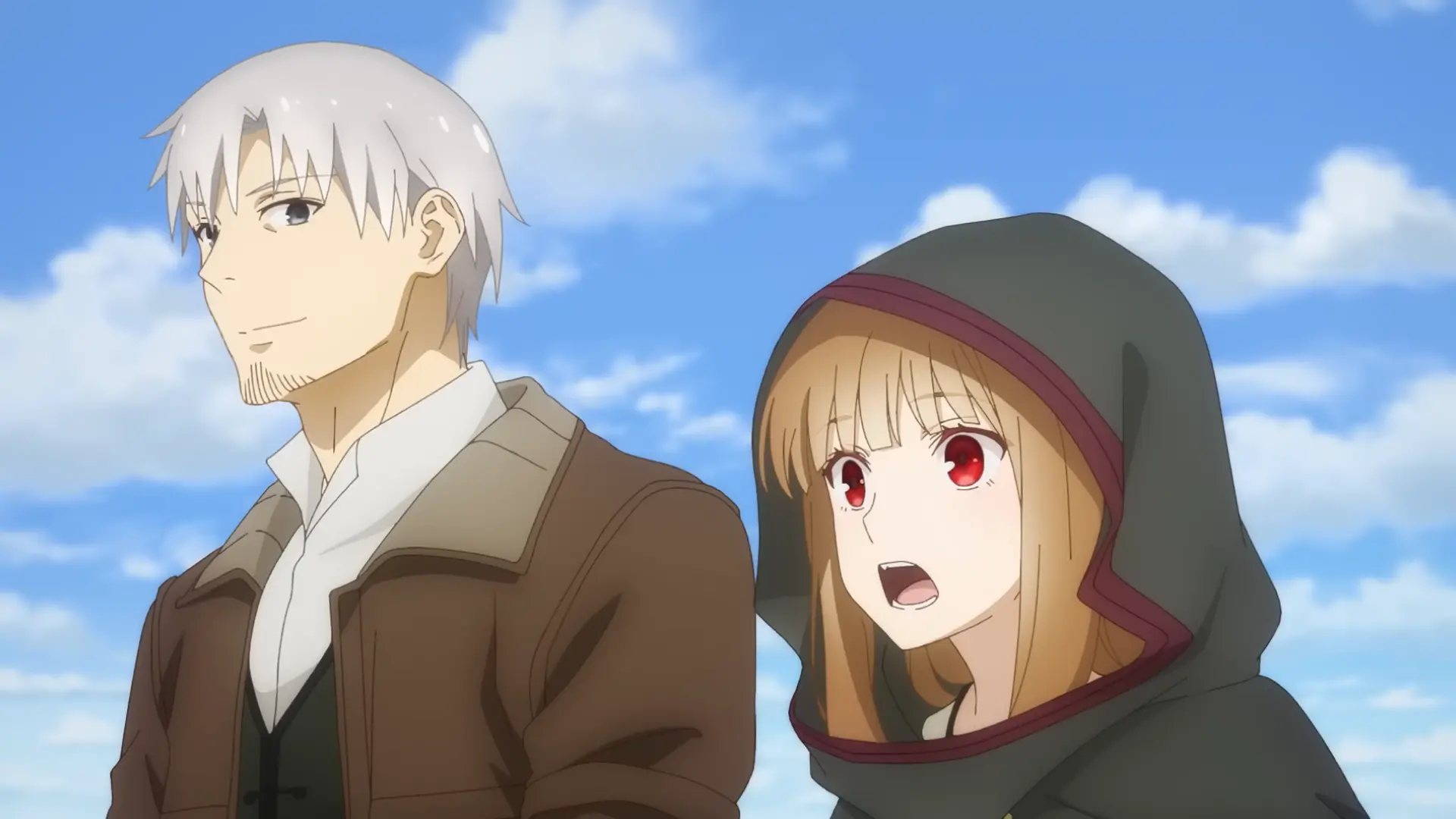
I've since learned Holo has "the form of a sweet 15-year-old girl" via @Kotobukiya_EN.
Besides these and a few more I didn't mention, the current lineup also includes eight new shows, at least two of which are anime-originals. There's even a baseball anime. This place could use more robots, though. Preferably giant ones, but I'm not going to be picky if the alternative is a robot-free-zone spanning three months, alas. It's probably hypocritical of me to say this, though, seeing as how I never got around to watching Brave Bang Bravern! during Winter 2024. I heard it's great. I suppose I could just watch that, but I can't resist New Season allure, and there's so much of it.
Note 1: I got to Spice and Wolf late, after its positive reputation was well established and generally uncontroversial. Well, I disliked nearly all of it for reasons too lengthy to include in this aside. I probably should have written a blog post detailing those reasons at some point instead of bitching about it on the IRC and on the Twitter (such as here, for example).
Posted in Hibike! Euphonium, Hibike! Euphonium 3, iDOLM@STER, THE, Kimetsu no Yaiba, Kono Subarashii Sekai ni Shukufuku wo!, Ookami to Koushinryou, Shiny Colors, Spice and Wolf, Yuru Camp△, Yuru Camp△ SEASON 3 | Tags: footnotes, Idols, Kayano Ai, Koshimizu Ami, Kyoto Animation, Light Novels, Magic School, May-December Romances, Remakes, Season Introduction, Sequels, Spring 2024, Twitter | Permanent Link
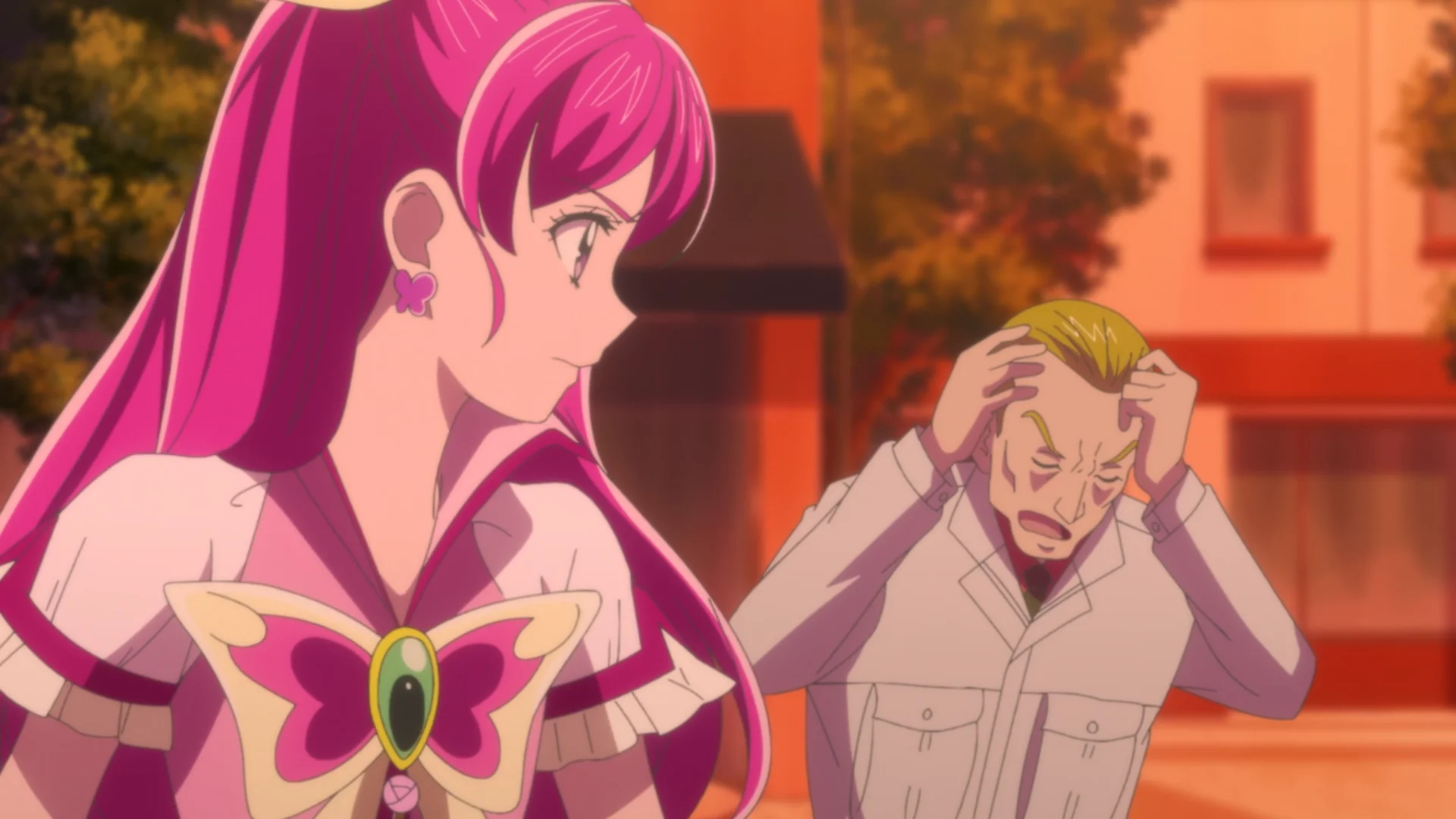
Believe it, Bunbee.
Should Kibou no Chikara ~Otona Precure '23~ (Power of Hope ~Precure Full Bloom~) be examined through the lens used for every other iteration in the Pretty Cure franchise, or should it be viewed (and judged) by standards applied to shows intended for adults? The expectations and allowances adopted can either magnify or diminish both the flaws (3DCG monsters, I'm looking in your direction) and the attributes of the series. I won't attempt to comprehensively address them all, but I bring this up now to acknowledge I'll be leaving some things unsaid. My attitude towards Otona Pretty Cure is generally positive, but you might catch a few laments if you follow me on the 𝕏 née Twitter.
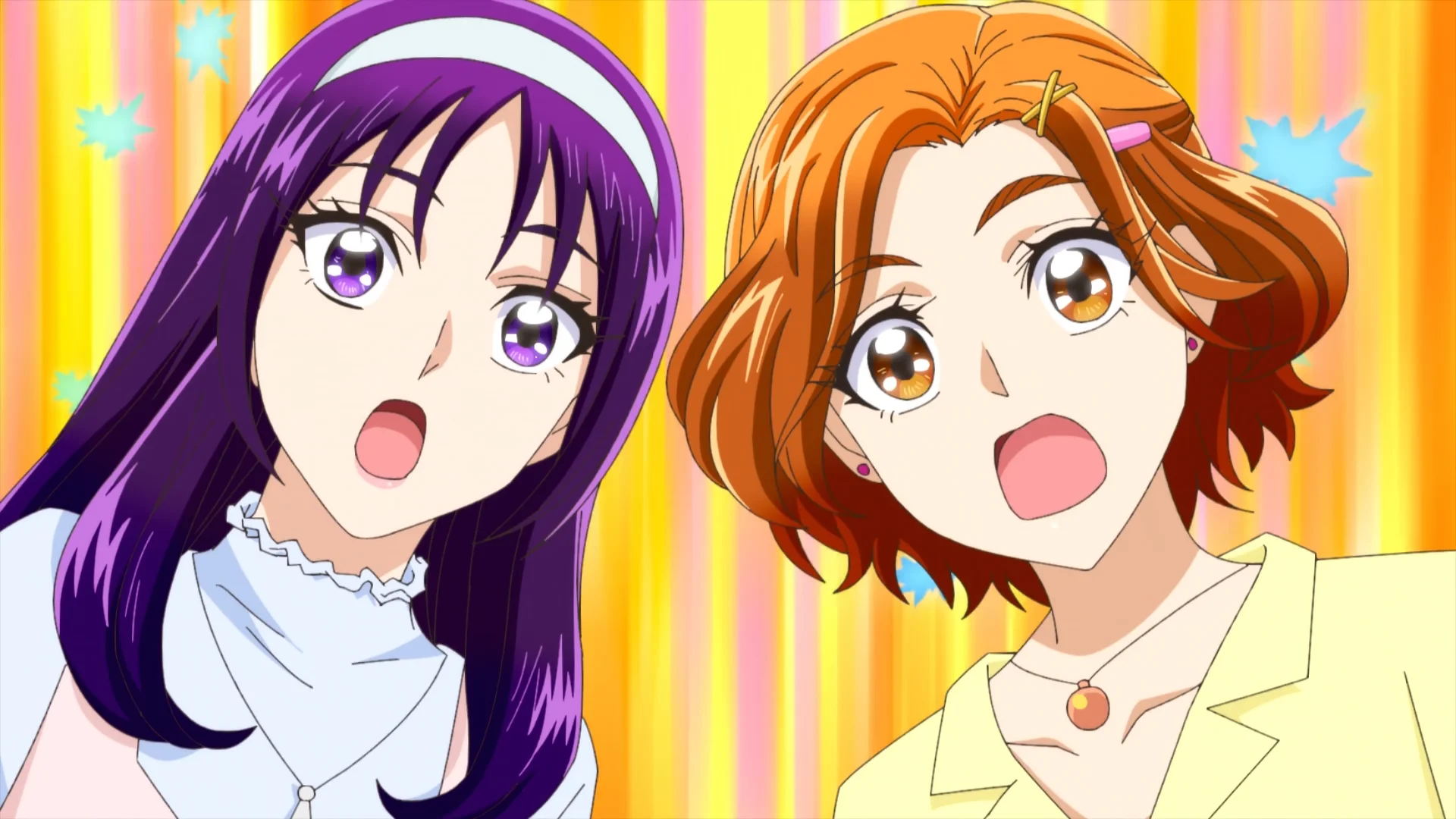
I'm shocked Saki ended up being the one with the best hair.
It still feels miraculous that Otona Precure exists at all. I also sort of got the sense that the production team shared this sentiment. Specifically, it seemed like I was watching a show being made by people who thought they only had one shot at this. That's not an unreasonable position to take. First Pretty Cure itself surely wasn't expected to launch a franchise that has run 20 years and counting. Maybe there will be more Otona Precure someday (the ending certainly leaves the possibility open), but it wouldn't be safe to assume there will be. Consequently, I got the impression there was pressure to cram as much as they could into the 12 episodes they had. (Yes, I'm aware there's some sort of Mahou Tsukai Precure! 2 thing planned, but I'm not expecting it to overlap with this.) Incidentally, there are spoilers the rest of the way out, so avert your eyes if you ain't watched this yet.
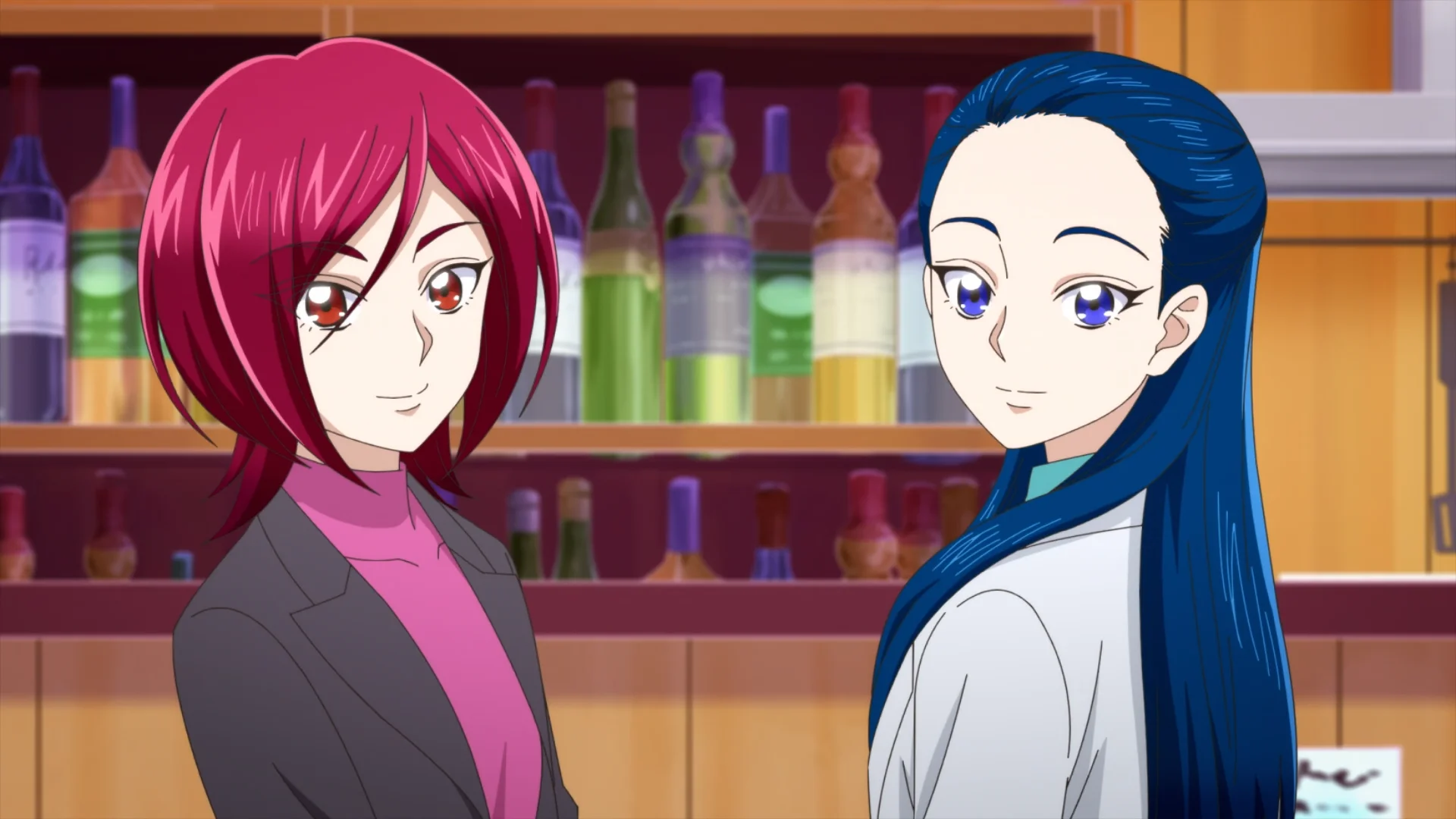
I wonder if all their paperwork is forged. I think they're technically illegal aliens.
Anyway, what I'm getting at is Otona Pretty Cure jammed a lot of stuff in here. Notably, Michiru and Kaoru finally got some recognition. As someone who has been constantly complaining about their omissions from team-up events and retrospectives, it was fantastic to see them return. Still, I'm on the fence about they way they were presented. Namely, I think they should still have at least some of the power they had in Splash Star. We did see them fly in the final episode, right? Possibly, they do have their powers, but chose to sit things out for the same reason Bunbee (who apparently does still have his powers) kept his head down and fled when pressed. But, yeah, this was a missed opportunity to officially confer upon them the Cure Bright and Cure Windy designations that they've long deserved.
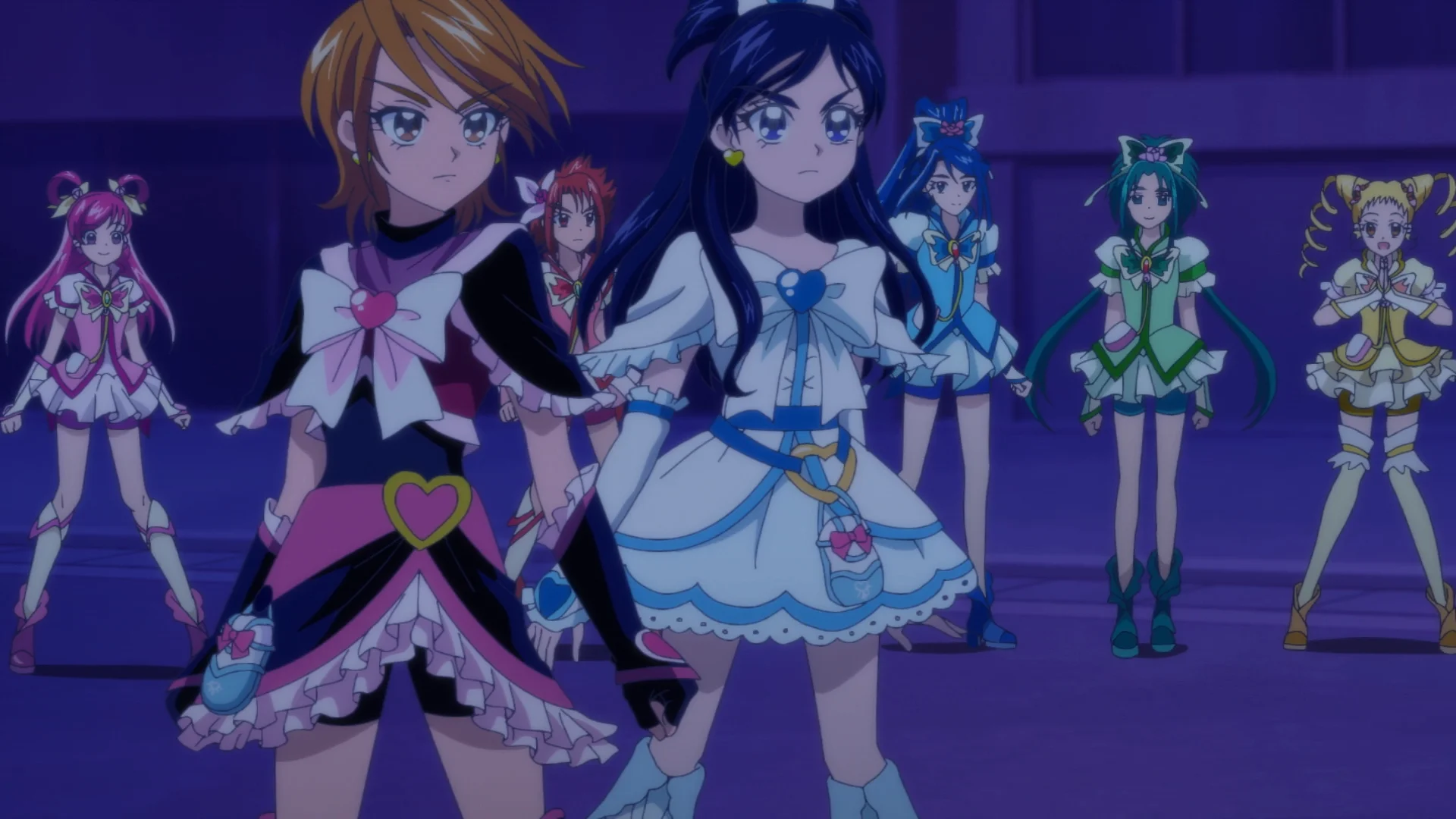
The opportunity to bring back the original battle costumes was right there!
So, no, Cure Bright and Cure Windy did not appear in any form, but Cure Black, Cure White, and Shiny Luminous all did. This was hidden from the promotional materials and made their appearance a bit of a surprise, but much less so considering it was telegraphed the instant Honoka's grandmother appeared in Otona Precure. As glad as I was to see them again, I would have preferred keeping them out of this season entirely, instead focusing on them in a future installment. Admittedly, that's difficult to do when there's no guarantee there will ever be any more later.
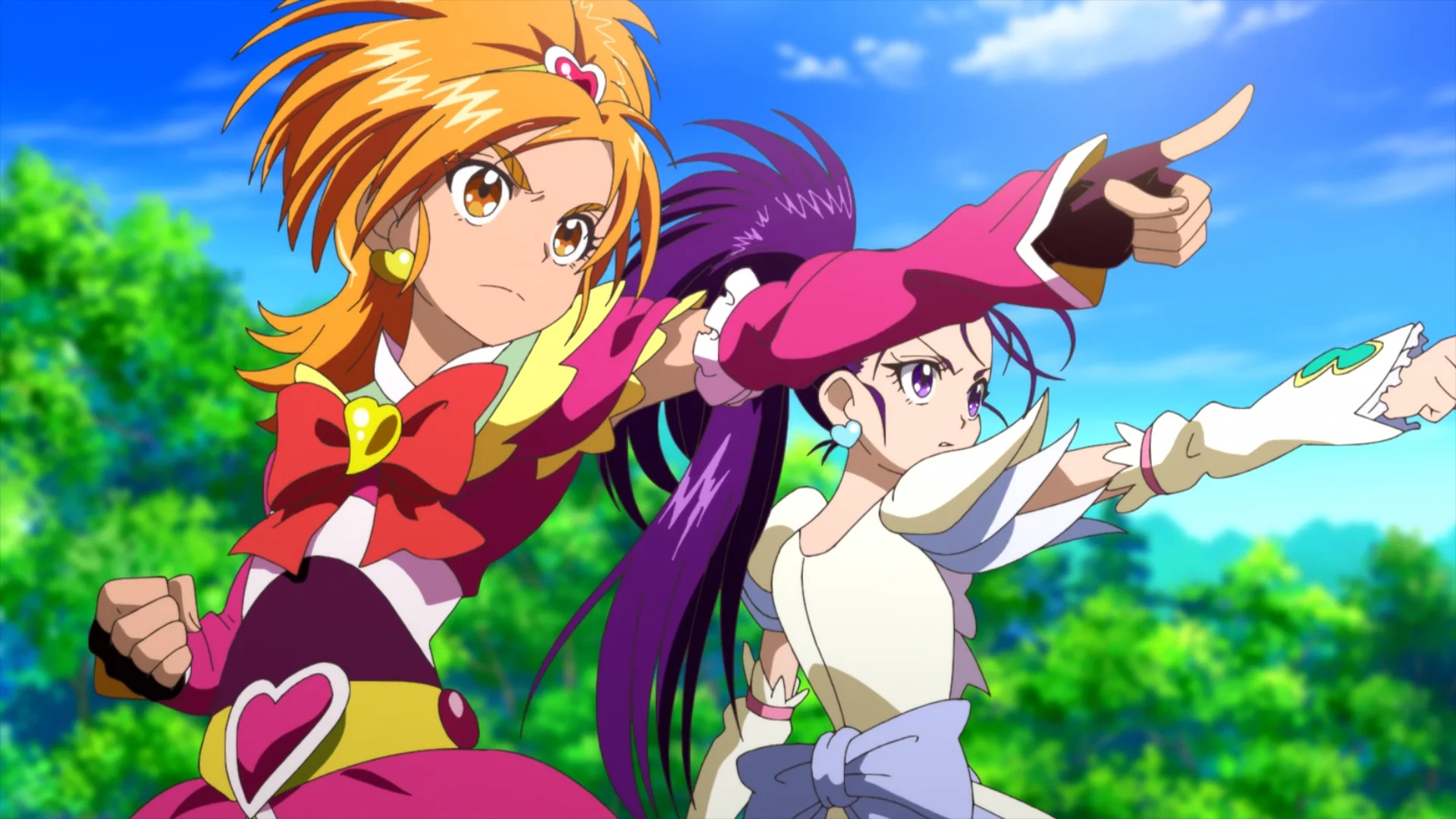
These two are so good.
I feel the need to point out the Max Heart and Splash Star teams were originally unable to unilaterally transform. They needed to be with their partners and their fairy counterparts. This would have been another reason to withhold first-generation Pretty Cure from Power of Hope ~Precure Full Bloom~. I would also have been okay with this limitation preventing Cure Bloom and Cure Egret from participating in the battles. Don't get me wrong, I love that Splash Star was included in this project, but Saki and Mai meant more to me than Bloom and Egret here. I think they could have still meaningfully contributed as regular adults who couldn't transform into Pretty Cure again, in contrast to the Yes! Cures who could.
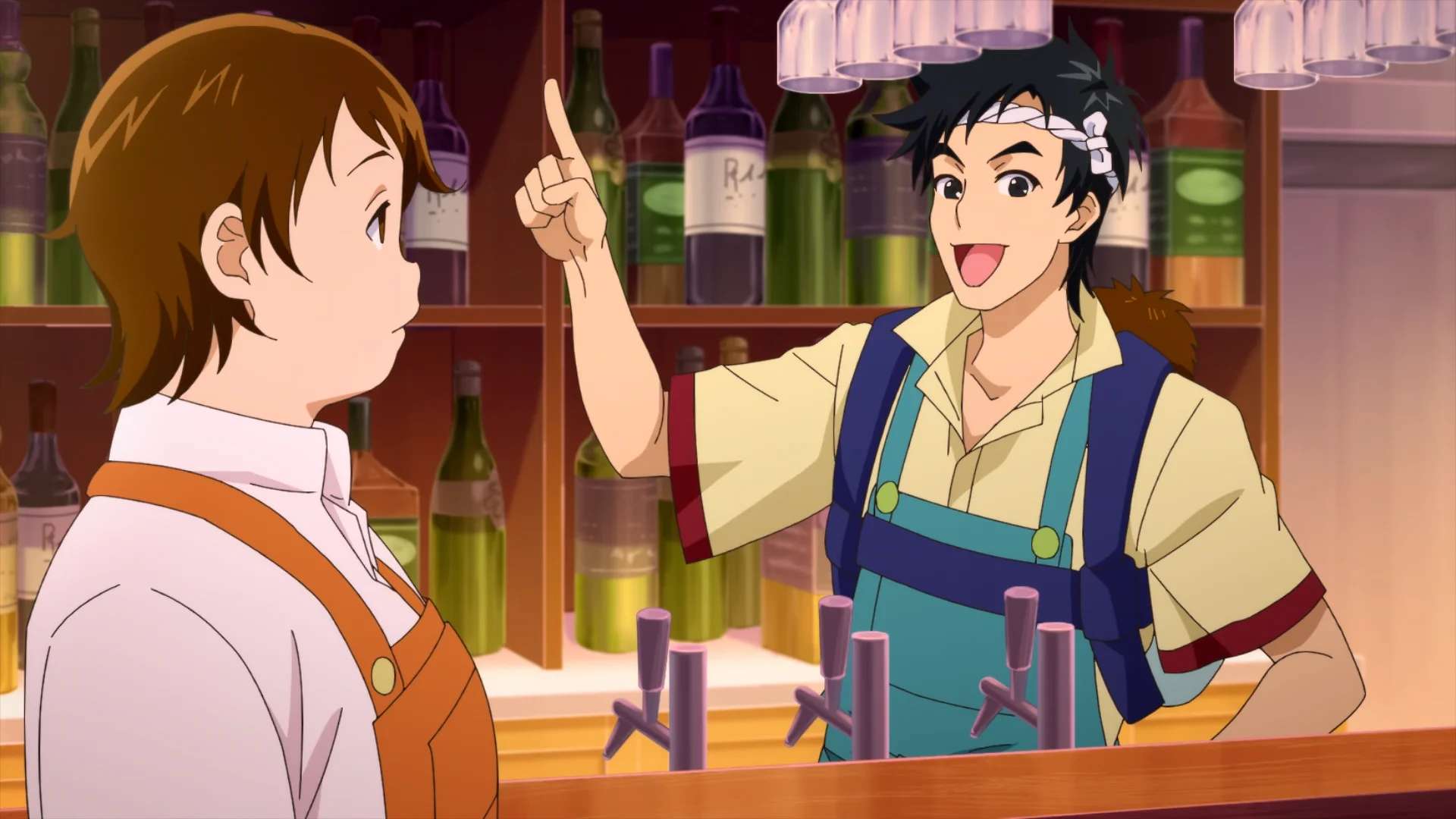
I wasn't expecting these two to be in the series at all.
Ultimately, the caveat expressed at the very start of Otona Precure (that there are many different possible futures, arguably making none of them capital-C Canon) ends up being the important factor. Maybe this is the possible future where Black, White, Luminous, Bloom, and Egret can all transform without their fairy mascot counterparts. Maybe this is the possible future where individual action can overcome industrialized irresponsibility. Maybe this is the possible future where the queen of Palmier Kingdom still works a day job in Japan. Oh. I'm going to have to address this, aren't I?
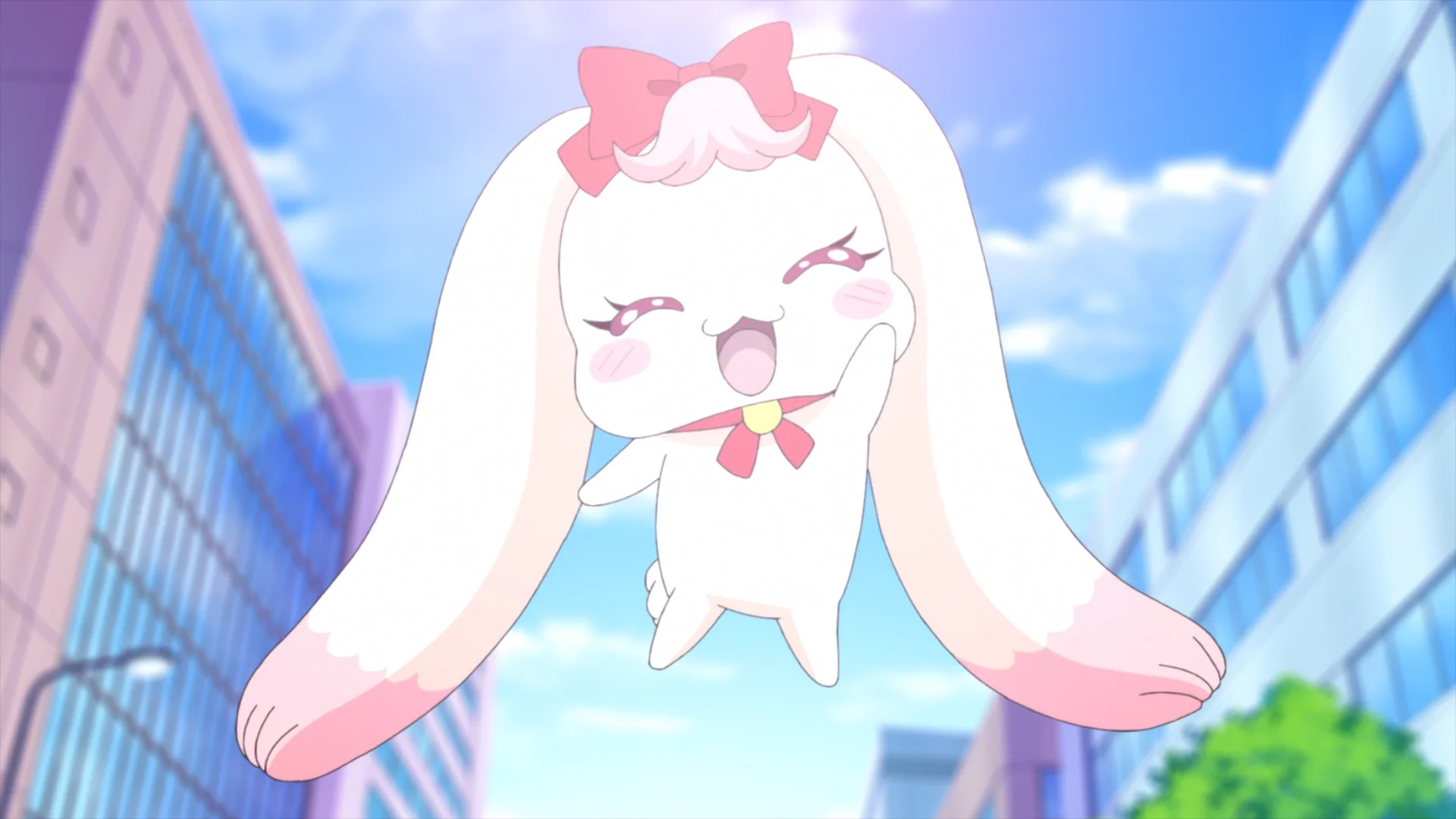
Otona Pretty Cure 2: Civil War.
I've never been a fan of the Nozomi x Coco 'ship, although I have to assume it's reasonably popular among the sort of audiences for whom Yes! Pretty Cure 5 was originally intended. In case you somehow still don't know, Coco is an adult who (we now learn) fell for Nozomi when he lured her into an alley met her by chance when she was 13. He was also her middle school teacher. Oh, and his human form is the alter ego of his real form, a ridiculous fairy mascot who is lucky to have Nuts by his side to make him look competent in comparison. And, yeah, he's the (a?) monarch of Palmier Kingdom, a country populated entirely by ridiculous fairy mascots doomed to fight an unavoidable water-rights war with the neighboring Donuts Kingdom. I expect losing this war will trigger the coup Milk has planned.
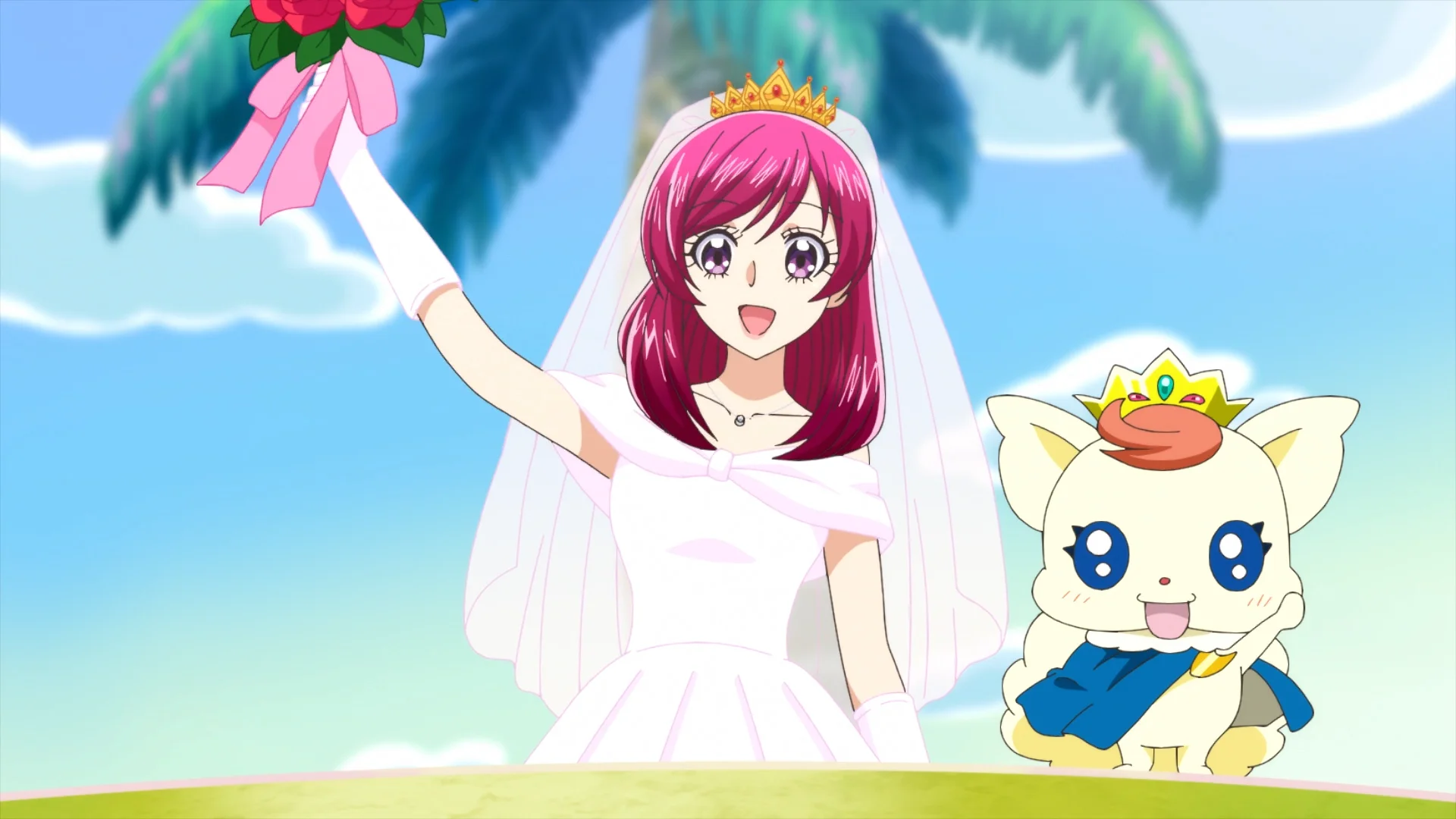
Was Coco in his fairy mascot form during the ceremony?
Did he include his verbal tic when reciting his vows?
ANYWAY, back in 2008, Coco and Nozomi (Cure Dream, technically) shared the first (and only?) on-screen kiss of the Pretty Cure franchise. Although Otona Precure did not feel beholden to pairing up Saki with Mai's brother, or Komachi with Nuts (Natts, whatever), or Urara with Syrup, it did not pass up the chance to goose the Nozomi x Coco 'shippers. So, now they're married (which really raises a lot of questions if you think about it even a little bit, but I recommend not dwelling on it at all), which explains why Coco was sort of hanging out for the second half of the show doing fuck all. He didn't need to be there, but I guess he did if he and Nozomi were going to get married. That didn't really need to happen during this season either, but I guess it did if "this season," is going to be "the only season," and there's no guarantee it's not. Maybe someday we'll get some more. Each tomorrow is but another possible future.
Posted in Futari wa Precure, Kibō no Chikara ~Otona Precure 23~, Pretty Cure (all), Splash Star, Yes! Precure 5 GoGo!, Yes! Pretty Cure 5 | Tags: Autumn 2023, Christmas Cake, Love Confessions, Mahou Shoujo, May-December Romances, Romance, Season Conclusion, Sequels, Spoilers, Twitter | Permanent Link
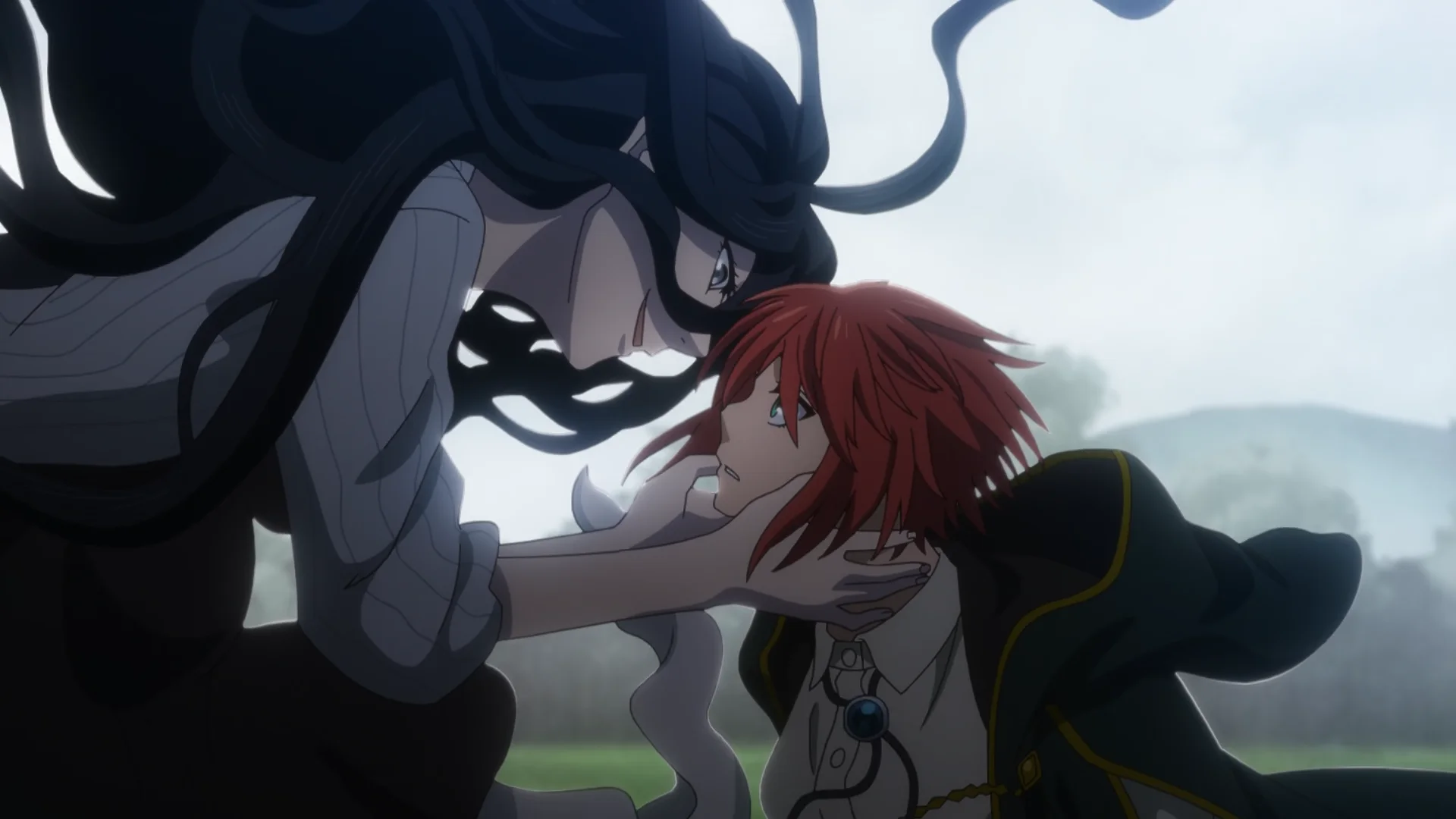
On the plus side, Ayako Doctrine invoked.
I've been buying the Mahoutsukai no Yome (The Ancient Magus’ Bride) manga for more than eight years. When I started, I didn't really think about how long I'd be reading it, let along buying it, but I do have volume 19 pre-ordered. I still enjoy it, but it's no surprise the story has evolved over that time. And when I say it has evolved, I mean it gained a magic school arc. This is also the focus of Mahoutsukai no Yome SEASON 2 Part 2, currently airing now. Seeing as how Chise is still a teenager, it does make sense to end her prolonged truancy. It's also providing more opportunities for her to interact with humans her age.
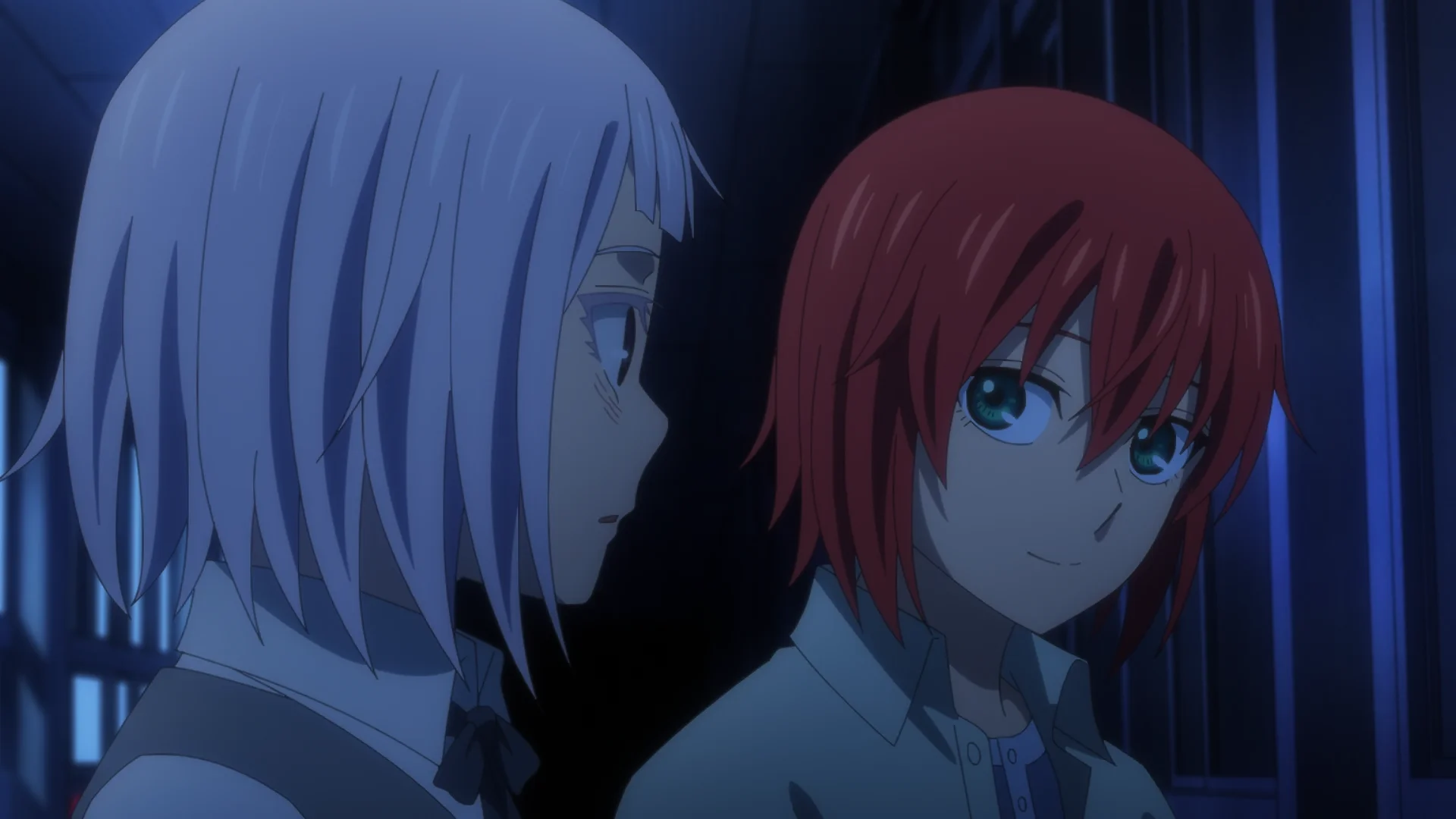
How you feel about Philomela will influence how you feel about the magic school arc.
Unfortunately, I—as the reader and viewer observing Chise's life of sorcery and mystical weirdness—don't care so much about the other humans her age. I mean, they're fine. A lot of them have had shitty lives, and some of them have exasperating hangups, as one might expect of humans in general and human teenagers in particular, but I don't find the sources of these tensions quite as engaging as one might expect. So yeah, I'm still watching the anime, and I'm still buying the manga, and I'm even still enjoying them both, but I do sometimes wish I could see what Silky has been up to instead.
Posted in Mahō Tsukai no Yome | Tags: 16-year-old love interests, Autumn 2023, AYAKO DOCTRINE, Magic School, Manga, May-December Romances, Season Introduction, Sequels | Permanent Link
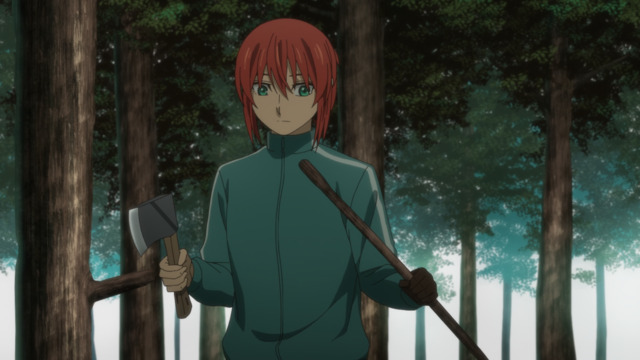
I can't see a green chav suit without thinking of Squid Game.
I can't identify anything I think the Mahoutsukai no Yome (The Ancient Magus Bride) anime is doing wrong necessarily, but I don't enjoy it as much as I like the manga. On the surface at least, the anime is great. It looks beautiful. The casting and voice acting are both spot on. The production values in general are high. And yet I mostly only find the overall experience simply okay. Does that mean the direction is at fault for not optimizing the presentation of all these elements? I dunno. I still like watching it, but it doesn't astound me, and maybe I'm just griping because I feel as if it ought to.
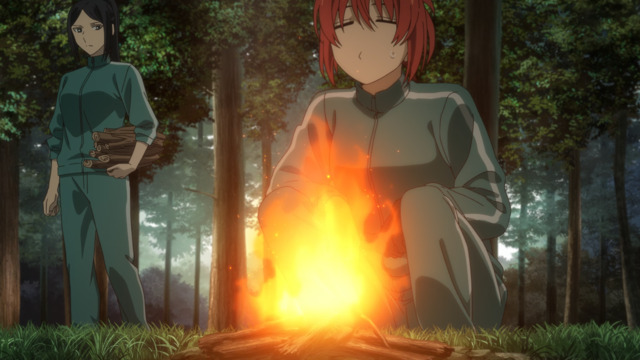
This is not Yuru Camp△.
As far as the currently airing second season goes, I suppose I'm naturally disinclined to be interested in its subject matter. Specifically, it is about Chise going to magic school. Aside from a few notable exceptions, I'm generally not enthused about magic schools as a setting. And taking someone out of an environment that was already interesting as a starting point, and then placing her in a magic school—well, that is objectively a step down. Nevertheless, I still find myself enjoying the corresponding manga arc despite my misgivings. In any case, the magic school setting is not exclusively why I'm never in a huge hurry to watch the latest episode of Mahoutsukai no Yome Season 2, but I can't rule it out as a contributing factor.
Posted in Mahō Tsukai no Yome | Tags: 16-year-old love interests, Initial impressions, Magic School, Manga, May-December Romances, Romance, Season Introduction, Sequels, Spring 2023 | Permanent Link
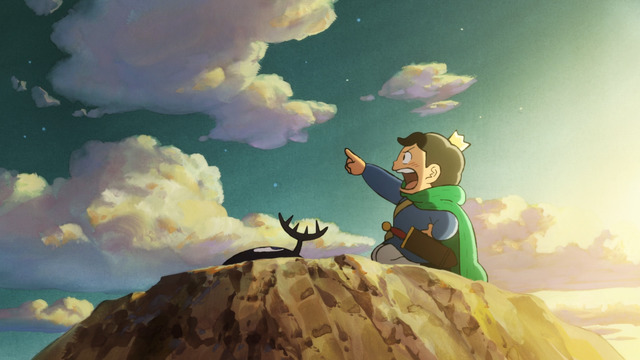
More of this would have been better.
I am going to caveat this by acknowledging first of all that Ousama Ranking (Ranking of Kings) was never actually capital-B Bad. However, I am hard pressed to identify another show with greater distance between how much I enjoyed it at the beginning and how disinterested I was by the end. I'm sort of appalled, to tell you the truth. Anime War Crime Tribunal provides a spoiler-heavy examination that covers basically every issue I had with the series, although I'm more negative about the problems overall.
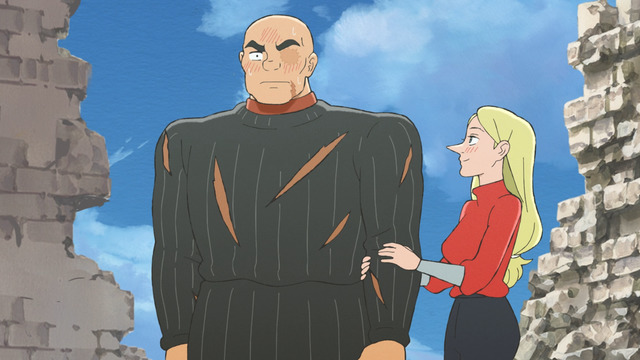
He's not going to be big enough for her.
I feel as if I must be overlooking shows that genuinely collapsed, but I suspect those examples that escape me at the moment likely showed less initial promise. Ousama Ranking, at a minimum, had a solid start (that admittedly started declining towards the end of its first cours). I did already mention that I was sick of all the fighting. Well, it went on like that during the second cours, but then the monkey's paw curled, the fighting stopped, and it got even worse. As I understand it, the source manga is still running, so maybe the story gets good again. The very end of the final anime episode did open the door for that possibility, but I'm in no hurry to revisit Ranking of Kings in any capacity for the time being.
Posted in Ousama Ranking | Tags: Autumn 2021, Bad Things Happen to Good People, Manga, May-December Romances, Sakamoto Maaya, Season Conclusion, Shounen Jive, Spoilers, Winter 2022 | Permanent Link

I know it's her (other) gimmick, but these are some fucked-up bangs.
Getsuyōbi no Tawawa 2 (Tawawa on Monday 2) is a follow-up to an Autumn 2016 adaption of Himura Kiseki's weekly illustrations that publish on the Twitter every Monday. There's continuity and regular characters whose lives intersect with otherwise unrelated story arcs. But really it's just an exercise in randy situation comedies involving enormous breasts. The anime episodes are short and faithfully follow the various stories, but it still looks weird to me without the blue-ink monochrome of the source material.
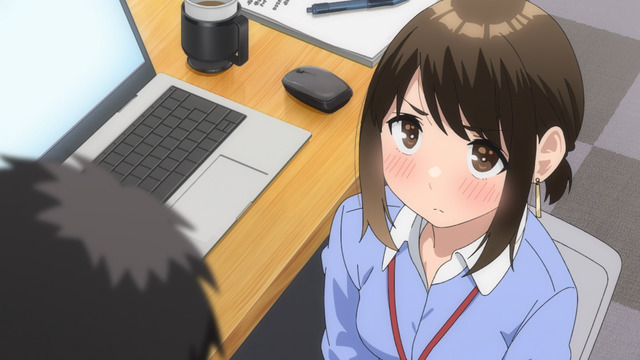
Never gonna happen.
Ganbare Dōki-chan (You Can Do It Dōki-chan) is another anime short and was paired with the Tawawa sequel for its debut because the Douki-chan artist and the Getsuyōbi no Tawawa artist collaborate on occasion. Unlike the Tawawa illustrations, Douki-chan follows a single story arc. Its titular heroine is a lovesick office lady who lacks the confidence to express her feelings to the co-worker she admires. Complicating the effort are myriad assertive rivals who always seem to appear at inopportune moments. Both Getsuyōbi no Tawawa 2 and Ganbare Dōki-chan have already concluded their 12-episode runs because they started toward the end of the Summer 2021 anime season. As anime adaptations go, they were all right, but it's good their episodes were short. I don't think either would have worked with full-length episodes.
Posted in Ganbare Dōki-chan, Tawawa on Monday | Tags: 16-year-old love interests, Autumn 2021, Bend Her Over a Kotatsu, Built for Sin, Childhood Friend, Fan Service, Hair, Initial impressions, Kayano Ai, Love Confessions, Love Triangle, May-December Romances, Plying Girls, Romance, Season Introduction, Sequels, Sex, Summer 2021, Turbo Lesbians, Twitter, Unrequited Love | Permanent Link
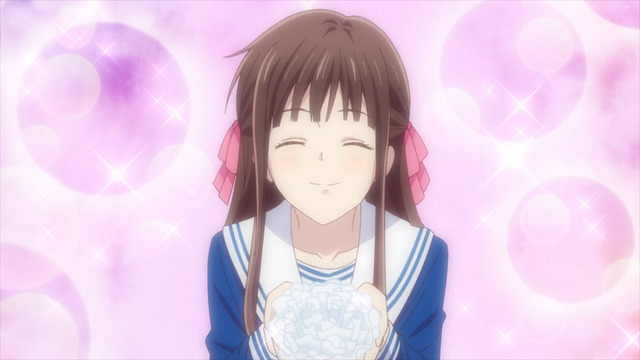
This is how everyone sees Honda Tohru and yet people
still manage to be assholes to her.
It's sort of difficult to talk about Fruits Basket: The Final because it's a 13-episode conclusion in a 63-episode adaptation of a well-regarded 23-volume manga. It's also a do-over succeeding a 26-episode series from 20 years ago which was also really good even though the source material hadn't ended yet. So, there's a lot going on.
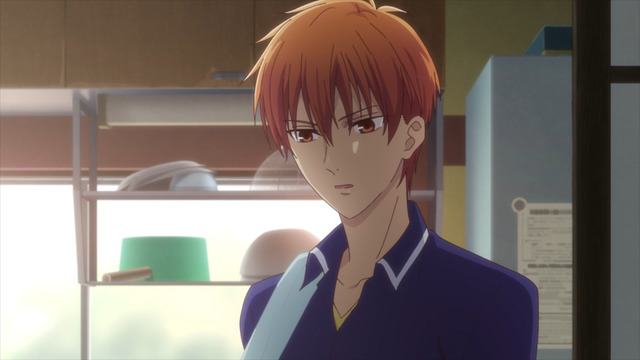
Is cat.
I do wish I had paid closer attention when I started watching this iteration of Fruits Basket when it began in 2019. There are a lot of characters, and there is a lot of setup, and I'm certain I missed a lot of subtleties early on. I suppose that is an argument in favor of re-watching the series, even if it is 63 episodes long, but that isn't going to happen until I've finally gotten around to reading the source material. It's gonna be a while.
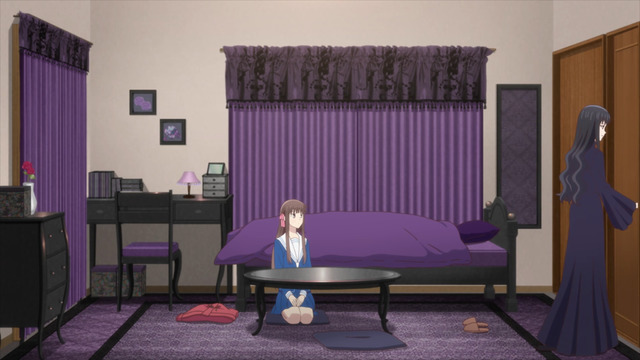
This bedroom is fantastic.
Probably everyone who has heard about Fruits Basket also knows opinions about it are almost universally favorable. Likewise, anyone thinking about getting into the series probably knows at least as much as I did concerning what it's ostensibly "about" before I watched the first anime (the 2001 one with Hocchan). One thing that surprised me as I got deeper into the plot is how monstrous the zodiac aspects are regarded in-universe. They're not set up that way at the start of the series at all.
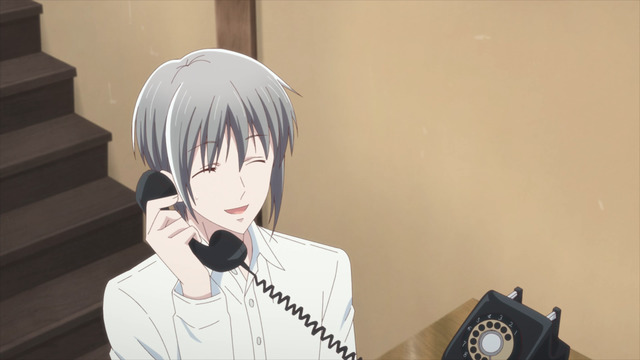
Look, a rotary phone.
I don't really want to write about Fruits Basket, since it's basically one of those shows where you can just sort of say, "Look, everyone says it's good. It is good. Just watch it." I can also see how it might not be for everyone. You have to have to have an appetite for romance and a tolerance for assholes. So many assholes. Honda Tohru is, like, the nicest, sweetest, goodest girl in the entire world and she's constantly surrounded by bitches being bitches and assholes being assholes. Back the fuck away from Honda Tohru, people.
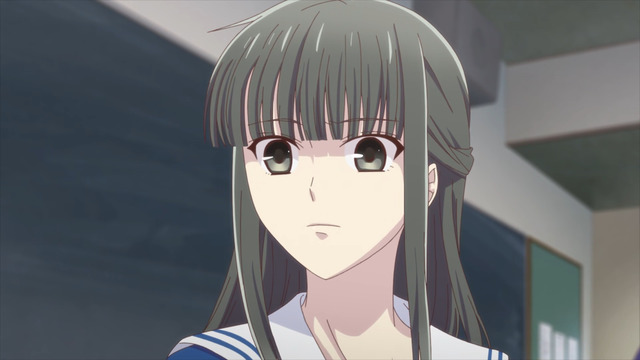
People are also assholes to Machi.
I guess viewers also have to be okay with "problematic" 'ships. I don't know if this heightened anxiety is an actual sign of the times, or if it's just localized sensitivity found on the Twitter. There are multiple age-gap pairings. There are people being mean to the people they love. Honda Tohru's mom dies. It's a whole thing. I guess the Fruits Basket 'ships are less "problematic" than the ones in Card Captor Sakura, but if these are the sorts of things that genuinely bother you, shoujo might not be for you.
Posted in Fruits Basket, RECOMMENDATIONS | Tags: 16-year-old love interests, Bedrooms, CATS, Crying, Ensemble Cast, Kugimiya Rie, Love Confessions, Love Triangle, May-December Romances, Plying Girls, Romance, Season Conclusion, Season Introduction, Sex, Shoujo, Spoilers, Spring 2019, Spring 2020, Spring 2021, Summer 2019, Summer 2020, tsundere, Twitter, Unrequited Love, Yui Horie | Permanent Link
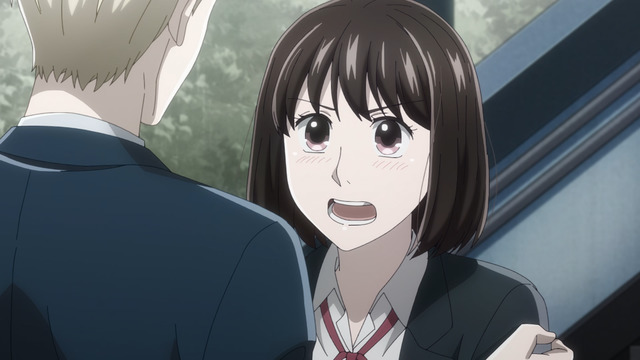
They're not flirting.
I started the Spring 2021 season with an entry covering both Koi to Yobu ni wa Kimochi Warui (It's Disgusting to Call This Love or KoiKimo) and Hige wo Soru. Soshite Joshikousei wo Hirou. (I Shaved. Then I Brought a High School Girl Home. or HigeHiro), so I guess I should have a post wrapping them up as well. I found KoiKimo to be a better series, perhaps because of its straightforward story. It also helps that KoiKimo leaves Ichika in control of her fate. It is ultimately Ichika's decision whether her relationship with Ryo will advance or not.
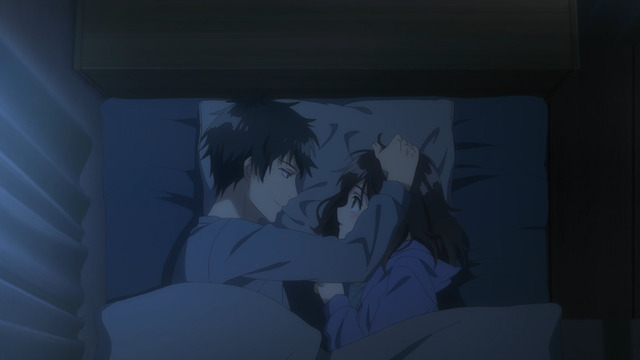
Platonic head pat.
Sayu does not have this luxury in HigeHiro. Maybe it's disingenuous to claim HigeHiro is about Yoshida "looking for something attractive to save" (my apologies to Liz Phair), but replace Yoshida's name here with "the audience's surrogate," and maybe it's not far off the mark. KoiKimo and HigeHiro both ended up where I expected, but Sayu had much less say over the path she took to get there.
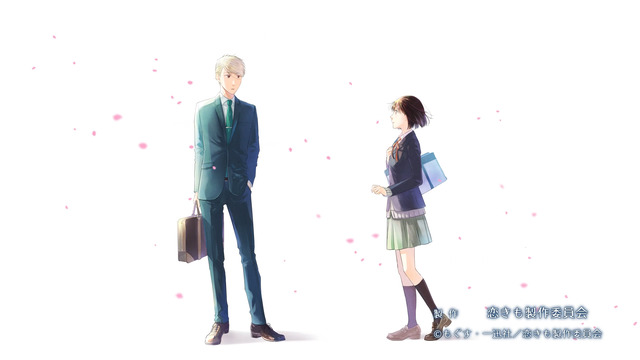
Making the end credits look more like the manga art was a nice touch.
In contrast, KoiKimo is an honest romance. There is no real mystery whether Ichika and Ryo will actually end up together or not, even though KoiKimo does introduce rival love interests for both leads. Moreover, the rivals are genuinely more sensible partners from every objective metric. However, the most obvioius impediment—the age gap between Ichika and Ryo—is never depicted as a meaningful obstacle. When it is finally viewed as a problem, its solution is entirely unsurprising.
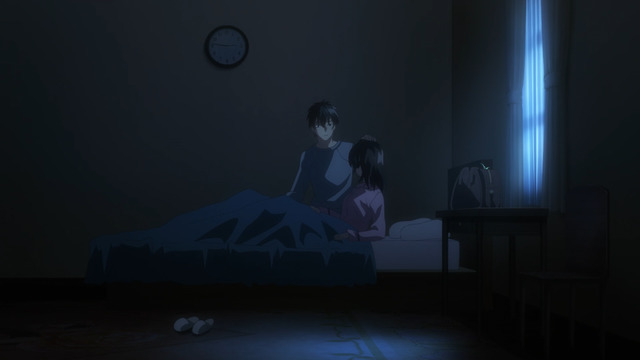
Platonic head pat.
The solutions to the challenges presented in HigeHiro are also fairly obvious, but the series insists on pantomiming a number of unconvincing feints. They're unconvincing because Sayu basically has no flaws, and Yoshida clearly feels something for her. He never has a reason to turn her away, and Sayu's rivals for Yoshida's attention are dubious love interests who quickly end up supporting Sayu anyway.
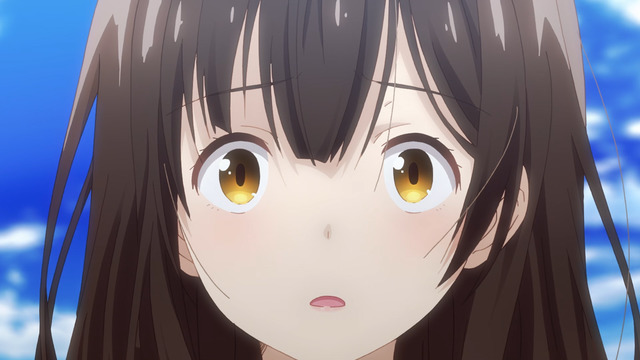
Relax, Sayu. Wonder Eggs are only 500 yen each.
In fact, Sayu's true adversaries are her lack of self-worth, her family's disinterest in her welfare, and the story's insistence at making Yoshida obtuse. Yoshida's behavior is baffling in HigeHiro, and not just because he denies being attracted to the sexually available high school girl living with him. Yoshida's behavior is baffling because he's willing to accept immediately on faith that Sayu would be better off returning to her home, without ever examining even the slightest bit the reasons why she ran away in the first place. It seems irresponsible to not at least contemplate the myriad awful situations that potentially compel teenagers to leave home and offer sex to strangers just to survive.
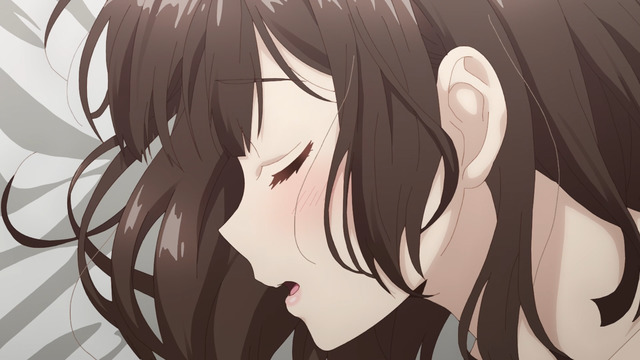
HigeHiro showed Sayu orgasming on screen.
Of course, the real reason Yoshida never asks is because the story can't let him or the audience know before the narrative is ready. It turns out the unpleasant situation Sayu fled wasn't that bad, but that's the case only because HigeHiro insists on rehabilitating its antagonists immedately after introducing them. This sort of cowardice is a significant weakness of HigeHiro, as it makes its conflicts fairly hollow. The challenges presented in KoiKimo are not intractable either, but at least they don't take on a fraudulent quality.

Ichika grew accustomed Ryo's nightly calls without realizing it.
KoiKimo succeeded by being forthright about its romance and committing to it unapologetically. In contrast, HigeHiro (like Yoshida himself) spends basically the entire series maintaining an unconvincing veneer of plausible deniability over whether or not Sayu is an actual love interest. At the risk of attracting accusations of being in favor of age-inappropriate pairings, I'm going to suggest HigeHiro does this to its detriment.
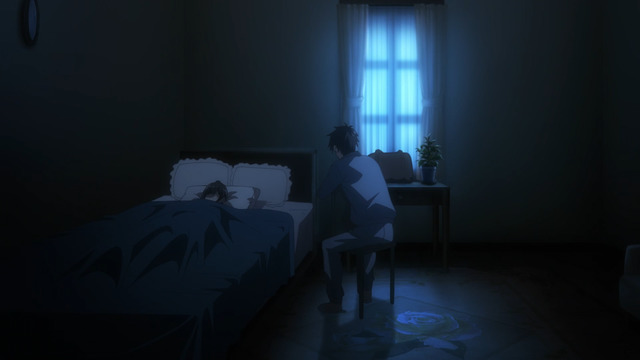
They had to put him in a chair watching her sleep
so people wouldn't insist they still fucked.
I suppose I can't speak for its source material, but the anime most certainly portrays Sayu as an eligible partner. Does HigeHiro provide Sayu with agency by having her test Yoshida's resolve each time she propositions him? Or does the series undermine Sayu's agency by presenting these moments solely so Yoshida can continue to rebuff her and showcase his unflagging integrity? I'm not answering this rhetorical, but I think we all know.
Posted in Hige wo Soru. Soshite Joshikousei wo Hirou., Koi to Yobu ni wa Kimochi Warui | Tags: 16-year-old love interests, Bad Things Happen to Good People, Bend Her Over a Kotatsu, Built for Sin, Christmas Cake, Compare and Contrast, Fan Service, Hanakana Distortion Field, Hanazawa Kana, Harem Comedy, Light Novels, Love Confessions, Love Triangle, Manga, May-December Romances, Plying Girls, Rape, Romance, Season Conclusion, Sex, Spoilers, Spring 2021, tsundere, Unrequited Love | Permanent Link
|
|






